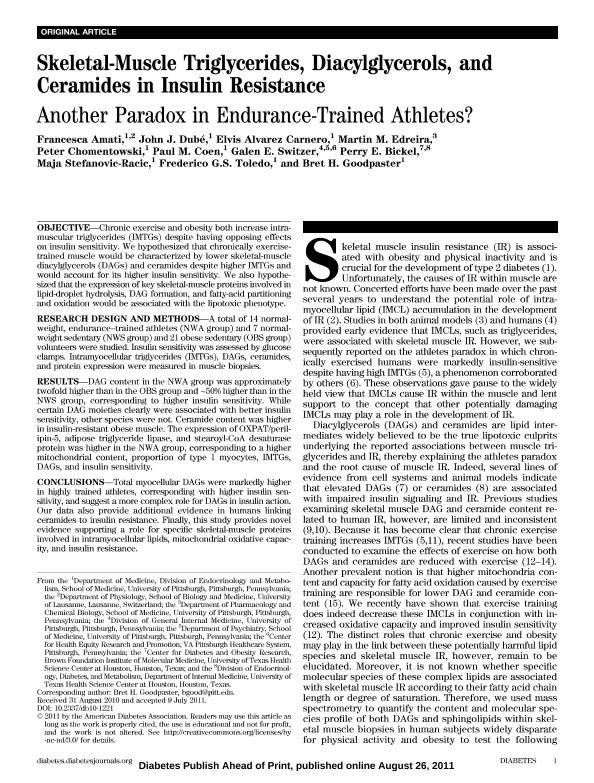Artículo
Skeletal muscle triglycerides, diacylglycerols, and ceramides in insulin resistance: Another paradox in endurance-trained athletes?
Amati, Francesca; Dubé, John J.; Alvarez Carnero, Elvis; Edreira, Martin Miguel ; Chomentowski, Peter; Coen, Paul M.; Switzer, Galen E.; Bickel, Perry E.; Stefanovic Racic, Maja; Toledo, Frederico G. S.; Goodpaster, Bret H.
; Chomentowski, Peter; Coen, Paul M.; Switzer, Galen E.; Bickel, Perry E.; Stefanovic Racic, Maja; Toledo, Frederico G. S.; Goodpaster, Bret H.
 ; Chomentowski, Peter; Coen, Paul M.; Switzer, Galen E.; Bickel, Perry E.; Stefanovic Racic, Maja; Toledo, Frederico G. S.; Goodpaster, Bret H.
; Chomentowski, Peter; Coen, Paul M.; Switzer, Galen E.; Bickel, Perry E.; Stefanovic Racic, Maja; Toledo, Frederico G. S.; Goodpaster, Bret H.
Fecha de publicación:
10/2011
Editorial:
American Diabetes Association
Revista:
Diabetes
ISSN:
0012-1797
Idioma:
Inglés
Tipo de recurso:
Artículo publicado
Clasificación temática:
Resumen
OBJECTIVE - Chronic exercise and obesity both increase intramyocellular triglycerides (IMTGs) despite having opposing effects on insulin sensitivity. We hypothesized that chronically exercisetrained muscle would be characterized by lower skeletal muscle diacylglycerols (DAGs) and ceramides despite higher IMTGs and would account for its higher insulin sensitivity. We also hypothesized that the expression of key skeletal muscle proteins involved in lipid droplet hydrolysis, DAG formation, and fatty-acid partitioning and oxidation would be associated with the lipotoxic phenotype. RESEARCH DESIGN AND METHODS - A total of 14 normalweight, endurance-trained athletes (NWA group) and 7 normalweight sedentary (NWS group) and 21 obese sedentary (OBS group) volunteers were studied. Insulin sensitivity was assessed by glucose clamps. IMTGs, DAGs, ceramides, and protein expression were measured in muscle biopsies. RESULTS - DAG content in the NWA group was approximately twofold higher than in the OBS group and ~50% higher than in the NWS group, corresponding to higher insulin sensitivity. While certain DAG moieties clearly were associated with better insulin sensitivity, other species were not. Ceramide content was higher in insulin-resistant obese muscle. The expression of OXPAT/ perilipin-5, adipose triglyceride lipase, and stearoyl-CoA desaturase protein was higher in the NWA group, corresponding to a higher mitochondrial content, proportion of type 1 myocytes, IMTGs, DAGs, and insulin sensitivity. CONCLUSIONS - Total myocellular DAGs were markedly higher in highly trained athletes, corresponding with higher insulin sensitivity, and suggest a more complex role for DAGs in insulin action. Our data also provide additional evidence in humans linking ceramides to insulin resistance. Finally, this study provides novel evidence supporting a role for specific skeletal muscle proteins involved in intramyocellular lipids, mitochondrial oxidative capacity, and insulin resistance.
Palabras clave:
Triglycerides
,
Diacylglycerols
,
Ceramides
,
Insulin Resistance
Archivos asociados
Licencia
Identificadores
Colecciones
Articulos(INGEBI)
Articulos de INST.DE INVEST.EN ING.GENETICA Y BIOL.MOLECULAR "DR. HECTOR N TORRES"
Articulos de INST.DE INVEST.EN ING.GENETICA Y BIOL.MOLECULAR "DR. HECTOR N TORRES"
Citación
Amati, Francesca; Dubé, John J.; Alvarez Carnero, Elvis; Edreira, Martin Miguel; Chomentowski, Peter; et al.; Skeletal muscle triglycerides, diacylglycerols, and ceramides in insulin resistance: Another paradox in endurance-trained athletes?; American Diabetes Association; Diabetes; 60; 10; 10-2011; 2588-2597
Compartir
Altmétricas



